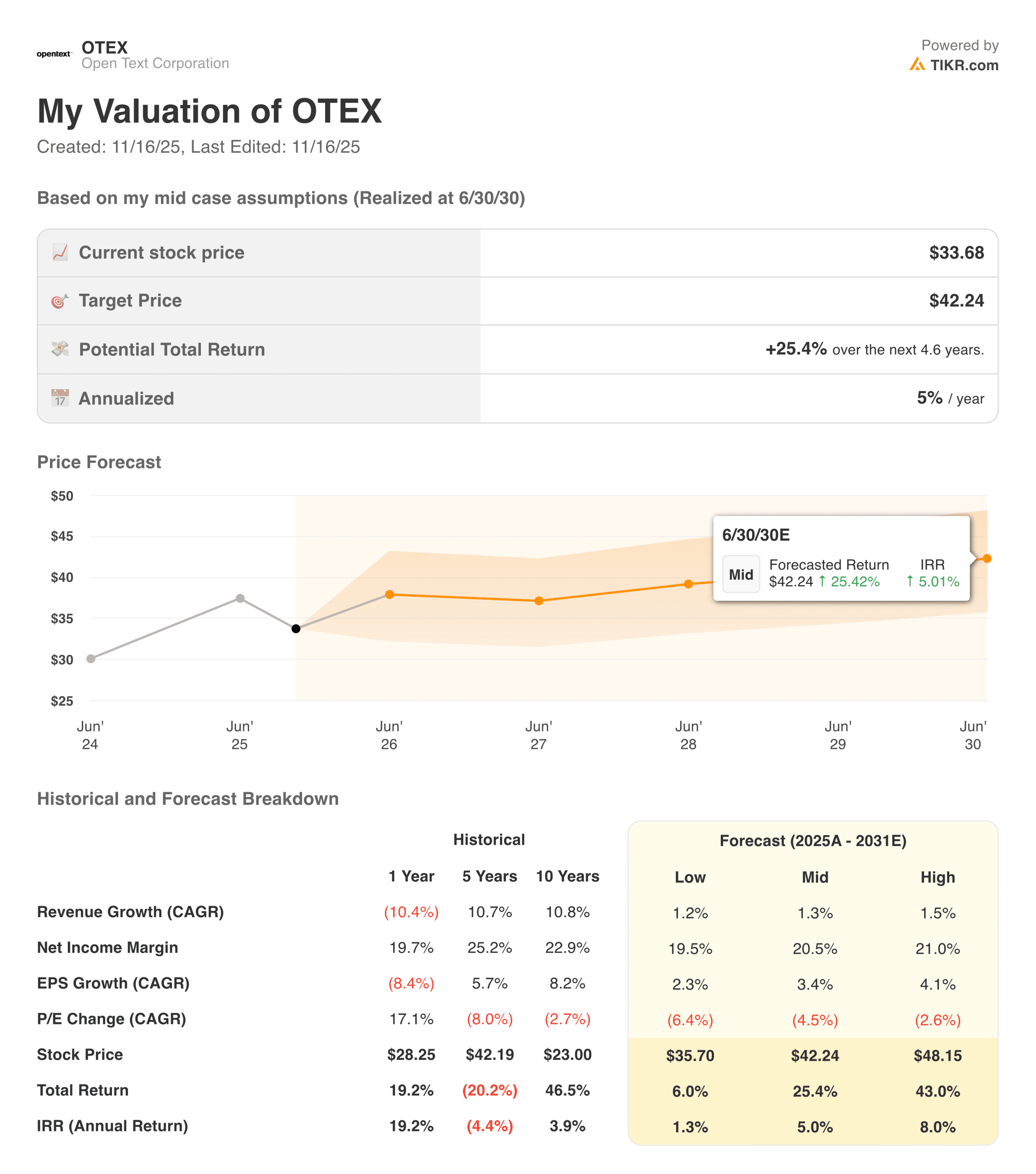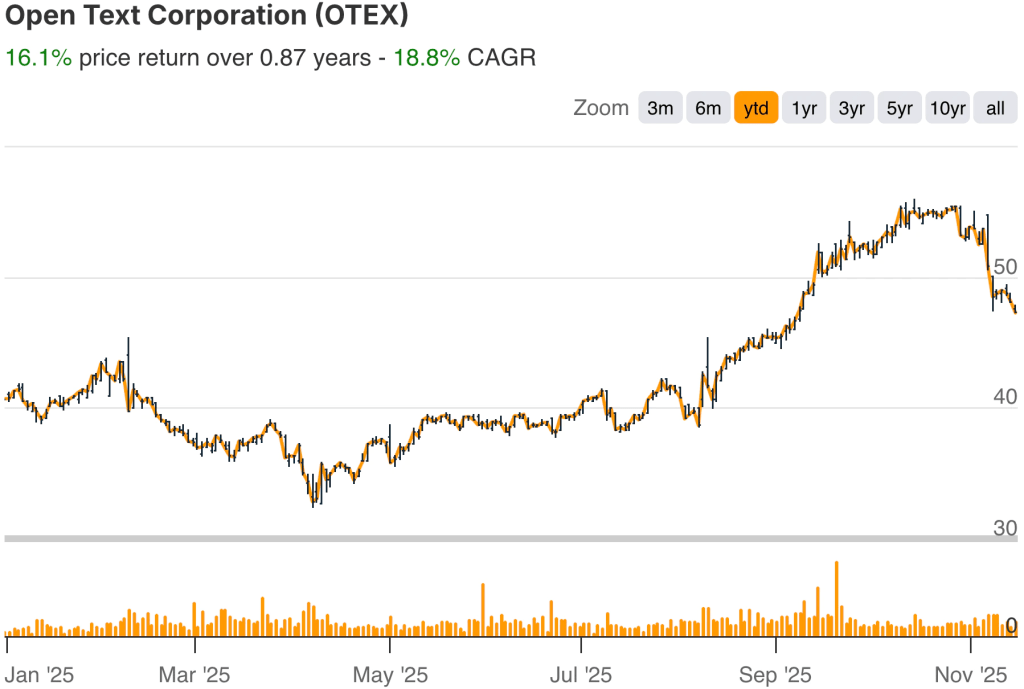OpenText (OTEX) sits in a category of enterprise software vendors that most people never interact with directly, but nearly every business relies on behind the scenes. Its portfolio spans information management, automation, cybersecurity, analytics, and cloud services. These systems power day-to-day operations for thousands of organizations worldwide. When this infrastructure works well, customers stay for years. When it needs to adapt, the business model depends on recurring revenue and long-term contracts. That structure helps OpenText maintain stability across different economic environments.
Discover how much upside your favorite stocks could have using TIKR’s new Valuation Model (It’s free) >>>
The company entered fiscal 2026 with a sharper focus on efficiency, cloud adoption, and better cash generation. Over the past two years, OpenText has completed significant acquisitions and integration work. That period created some complexity, but it also expanded the company’s scale and capabilities. Fiscal Q1 offered a clearer view of a business working to streamline operations and accelerate its cloud transition. These efforts form the foundation of what the company wants to build in 2026.

Investors now want to understand whether today’s changes will lead to stronger performance next year. The early signs from Q1 show a company operating with more discipline. Revenue trends reflect the scale of the installed base, margin improvements show progress on cost actions, and cash flow is moving in the right direction. None of these shifts creates sudden acceleration, but they do suggest a company positioning itself for more stability after a period of heavy transformation.
Quickly value any stock with TIKR’s powerful new Valuation Model (It’s free!) >>>
Financial Story
OpenText reported 1.45 billion dollars in total revenue for Q1 fiscal 2026, reflecting a modest year-over-year decline. The company continues to operate in a mixed demand environment. Some customers remain cautious with new projects, while others are increasing spending on cloud, security, and automation. This blend keeps revenue steady but still leaves room for improvement.
Cloud revenue reached $ 655 million, and cloud annual recurring revenue stood at $ 2.5 billion. These numbers show that cloud remains one of the strongest parts of the portfolio and a core driver of long-term value.
| Metric | Q1 FY26 | YoY Change |
|---|---|---|
| Total Revenue | 1.45B | Slightly lower |
| Cloud Revenue | 655M | Higher |
| Cloud ARR | 2.5B | Higher |
| Adjusted EBITDA | 512M | Higher |
| Adjusted EBITDA Margin | 35.4% | Higher |
| Operating Cash Flow | 302M | Higher |
| Free Cash Flow | 229M | Higher |
| Total Debt | 8.3B | Lower |
| Cash on Hand | 347M | Higher |
| Debt Paid Down in Quarter | 676M | — |
Margins showed encouraging progress, with adjusted EBITDA reaching $ 512 million, representing a 35.4 percent margin, an improvement from the previous year. This reflects ongoing cost efficiency measures and integration benefits from past acquisitions. Operating discipline helped offset the softer revenue backdrop. The company also delivered 302 million dollars in operating cash flow, a meaningful improvement driven by better working capital management and tighter operating controls.
The balance sheet also saw progress. OpenText reduced its total debt to $8.3 billion and ended the quarter with $347 million in cash. The company paid down 676 million dollars of debt in the quarter, highlighting a clear commitment to improving financial flexibility. These moves matter because a stronger balance sheet gives OpenText the room it needs to keep investing in cloud, security, and AI-driven capabilities while working toward a steadier financial profile in 2026.
Look up OpenText’s full financial results & estimates (It’s free) >>>
Broader Market Context
Enterprise software demand remains stable but uneven. Companies continue to prioritize systems that improve efficiency, enhance cybersecurity, and automate processes. At the same time, discretionary IT projects remain slower to commit. This mix creates a predictable environment for recurring revenue but limits growth from new licenses and large transformational deals. For a company like OpenText, the priority becomes increasing cloud adoption, improving customer retention, and delivering better operating leverage.
AI is also reshaping expectations. Customers want platforms that integrate information management with intelligent automation. OpenText operates at this intersection, and fiscal 2026 gives the company opportunities to expand more deeply into these areas. The challenge comes down to execution. The company must continue connecting its product ecosystem in ways that make AI capabilities easier for customers to adopt at scale. This part of the story becomes more important as 2026 approaches.
1. Cloud Momentum Remains the Anchor
Cloud remains one of OpenText’s most durable growth engines. Q1 highlighted why. Cloud revenue held up well, and cloud ARR reached 2.5 billion dollars. This recurring base helps smooth short-term volatility in other parts of the business. It also drives higher retention, better visibility, and more predictable cash flow. These characteristics make the cloud an important part of the company’s long-term financial stability.
The transition toward the cloud is still underway, and revenue may fluctuate quarter to quarter. Even so, the trajectory remains positive. As more customers shift from on-premises systems to cloud-based services, OpenText gains stronger margins and a more consistent revenue foundation. This ongoing mix shift helps shape the company’s outlook as it works to strengthen performance through fiscal 2026.
2. Margin Improvements Show Better Operational Discipline
The first quarter of 2025 demonstrated progress on margins as adjusted EBITDA rose to 512 million dollars, and the margin improved compared to last year. These gains reflect better cost execution and continued synergies from past acquisitions. OpenText also focused heavily on aligning its cost structure with its revenue profile. That work is starting to show up in operating performance.
The path into 2026 depends on maintaining this discipline. Cost management allows the company to preserve cash flow even when revenue growth remains limited. As cloud penetration increases and older systems phase out, efficiency gains become even more important. Margin improvement is not a one-quarter story for OpenText. It is a multi-quarter effort that will influence the company’s performance going forward.
Value stocks like IGM Financial in less than 60 seconds with TIKR (It’s free) >>>
3. Debt Reduction Strengthens Flexibility
One of the most important developments in Q1 was debt reduction. OpenText paid down 676 million dollars of debt and ended the quarter with 8.3 billion dollars in total debt. This move improves leverage and reduces financial risk. A healthier balance sheet gives the company more room to invest in key areas like cloud, AI, and security while maintaining long-term stability.
This shift also helps OpenText approach 2026 with more flexibility. Lower leverage improves optionality, whether through investments, additional cost actions, or more resilient cash generation. While debt remains elevated, the company’s progress shows a clear intention to strengthen its financial position. That long-term focus matters for investors evaluating the company’s path into 2026.
The TIKR Takeaway

TIKR shows a company working through a multi-quarter reset. Revenue remains steady, cloud ARR continues to grow, margins are improving, and cash flow is strengthening. When viewed through TIKR’s long-term financial charts, OpenText looks like a company building stability through better execution. Fiscal 2026 depends on maintaining this momentum, and OpenText appears to be moving in the right direction.
Should You Buy, Sell, or Hold IGM Financial Stock in 2025?
The company is not yet showing breakout growth, but it is showing clearer discipline. Stronger cloud ARR, rising margins, better cash flow, and meaningful debt reduction all support a more stable foundation. The key question for 2026 is execution. If the company continues to improve performance across cloud, security, and AI-driven solutions, the long-term case becomes more compelling.
How Much Upside Does IGM Financial Stock Have From Here?
With TIKR’s new Valuation Model tool, you can estimate a stock’s potential share price in under a minute.
All it takes is three simple inputs:
- Revenue Growth
- Operating Margins
- Exit P/E Multiple
If you’re not sure what to enter, TIKR automatically fills in each input using analysts’ consensus estimates, giving you a quick, reliable starting point.
From there, TIKR calculates the potential share price and total returns under Bull, Base, and Bear scenarios so you can quickly see whether a stock looks undervalued or overvalued.
Estimate a company’s fair value instantly (Free with TIKR) >>>
Looking for New Opportunities?
- See what stocks billionaire investors are buying so you can follow the smart money.
- Analyze stocks in as little as 5 minutes with TIKR’s all-in-one, easy-to-use platform.
- The more rocks you overturn… the more opportunities you’ll uncover. Search 100K+ global stocks, global top investor holdings, and more with TIKR.
Disclaimer:
Please note that the articles on TIKR are not intended to serve as investment or financial advice from TIKR or our content team, nor are they recommendations to buy or sell any stocks. We create our content based on TIKR Terminal’s investment data and analysts’ estimates. Our analysis might not include recent company news or important updates. TIKR has no position in any stocks mentioned. Thank you for reading, and happy investing!








